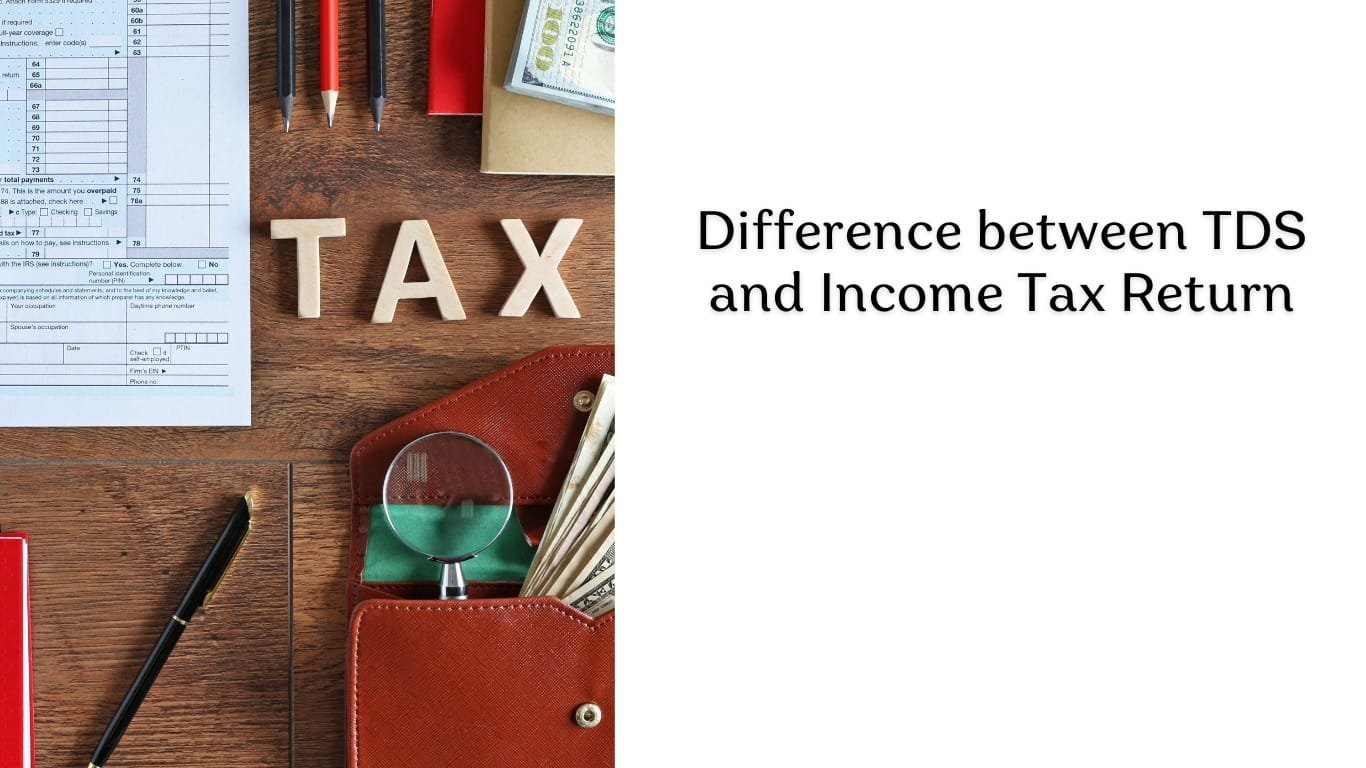Difference between TDS and Income Tax Return
Difference between TDS and Income Tax Return Many taxpayers often confuse the terms Tax Deducted at Source (TDS) and Income Tax Return (ITR). For salaried individuals, it’s essential to comprehend the distinctions between TDS and ITR to grasp their impact on tax liability and refunds. The primary disparity lies in the fact that TDS entails the tax deducted from the payer’s income sources based on the anticipated tax liability, while Income Tax is deducted from the payer’s overall profit or annual return. Difference between TDS and Income Tax Return This article delves deeper into the variances between these terms, offering definitions, advantages, and insights into the filing procedures.
What is TDS?
Difference between TDS and Income Tax Return TDS, short for Tax Deducted at Source, is a tax collection mechanism mandated by the Government of India. It requires individuals or corporations making specified payments, such as salary, interest, rent, or professional fees, to deduct a certain percentage of tax before disbursing the payment. Essentially, the tax is deducted directly from the payer’s source of income. Difference between TDS and Income Tax Return The deducted tax amount is then remitted directly to the government, ensuring a steady flow of revenue and distributing the responsibility of tax collection among various payers. TDS plays a vital role in curbing tax evasion and streamlining the tax collection process.
Procedure to File a TDS Online
Below, you can find information on the eligibility criteria and the exact procedure for filing TDS online.
Eligibility Criteria to File TDS
The types of payments where TDS may be applicable:
- Salary Payment
- Earnings from Investments
- Money from winning contests, riddles, and similar activities.
- Winnings from horse races
- Commissions from insurance
- Payments associated with the National Savings Scheme and miscellaneous other sources.
Step-by-Step Process to File a TDS Online
The steps to file TDS online:
- Go to the income tax e-filing website.
- Sign in using your TAN (Tax Deduction or Collection Number) and password.
- Click on the ‘e-file’ option on the dashboard, then select ‘Income tax forms’ and proceed to choose ‘File Income Tax forms’.
- Select the form that you have decided to file.
- Proceed to ‘Upload TDS Form’ and then Click on ‘Let’s Get Started’ Option.
- Enter the required details accurately and then click on ‘Proceed to verify’.
- Validate the return by entering the OTP sent to your registered mobile number to complete the process.
- After completing the process, you will receive a success message confirming the submission. If you haven’t already generated the Digital Signature Certificate (DSC), you can use the Electronic Verification Code (EVC) to validate the TDS statements.
Advantages of TDS
The benefits of Tax Deducted at Source (TDS):
- Prevention of tax evasion: TDS prevents people from evading taxes since the tax is collected at the source before income generation.
- Steady revenue flow: TDS ensures a steady flow of revenue for the government, helping it meet budgetary requirements and fund public welfare initiatives.
- Expansion of tax collection base: TDS expands the tax collection base by covering a wide range of income sources and transactions.
- Reduced burden: TDS reduces the burden on both tax collection agencies and the deductor (payer) by automating the tax collection process.
- Convenience for deductees: TDS ensures convenience for deductees since the tax is deducted automatically, eliminating the need for manual tax payments.
What is Income Tax?
Income Tax is a levy imposed on the yearly earnings of individuals or corporations within a fiscal year. Governed by the Income Tax Act of 1961, it establishes guidelines for income tax computation, evaluation, and collection. Income tax applies to various revenue streams, including salaries, income from property rental, profits from professional activities or businesses, and capital gains. Difference between TDS and Income Tax Return Indian citizens earning more than Rs. 2.5 lakhs annually are obligated to pay income tax; failure to comply results in penalties.
The procedure for filing Income Tax online
We have furnished details about the eligibility criteria and the comprehensive procedure for filing an Income Tax Return (ITR) online.
Eligibility Criteria to File Income Tax
The income tax filing requirements are as follows:
- Any individual whose annual income exceeds Rs. 2.5 Lakhs.
- For senior citizens aged between 60 and 80 years, the threshold is Rs. 3 Lakhs.
- For senior citizens aged above 80 years, the threshold is Rs. 5 Lakhs.
Step-by-Step Process to File Income Tax Online
- Difference between TDS and Income Tax Return Go to the Income Tax e-filing website and click on the ‘Login’ button.
- Enter your login credentials carefully to access your account.
- Click on the ‘e-file’ tab and then select ‘File Income tax return’.
- Difference between TDS and Income Tax Return

Difference between TDS and Income Tax Return Choose the financial year for which you want to file your income tax returns and click on ‘continue’.
- Difference between TDS and Income Tax Return Select your filing status (individual, Hindu Undivided Family (HUF), etc.) and the type of income tax return you wish to file.
- Provide accurate details of your bank account or ensure pre-validation if already submitted.
- You’ll be directed to a new page with the information you’ve filled in. Review all details for accuracy, then confirm the summary of your returns and validate it.
- Difference between TDS and Income Tax Return The final step is to verify your returns. This verification process is mandatory. After verification, you’ll need to send the hard copy to the Income Tax Department.
Advantages of Income Tax
key points regarding the importance of filing Income Tax Returns (ITRs):
- It helps prevent penalties and unnecessary consequences associated with non-compliance.
- ITRs hold significant legal value as they are recorded with the government, serving as official documentation of one’s income and tax liabilities.
- They are essential documents when applying for bank loans or any other financial transactions requiring proof of income.
- The government utilises the information from ITRs to improve various sectors such as healthcare, education, infrastructure, etc., by allocating funds based on tax revenues.
- Difference between TDS and Income Tax Return Filing taxes is considered a civic duty and is often viewed as a contribution towards the development and maintenance of a civilised society.
https://taxgyany.com/product-category/income-tax-return/
What are the differences between TDS and Income Tax?
Tax Deducted at Source (TDS) is deducted from the source of income periodically throughout the year, while Income tax is paid by the taxpayer at the end of the financial year.
TDS deducts tax from specified payments made by a person or business to the deductee, Difference between TDS and Income Tax Return while Income tax is charged on the annual income earned by the individual or entity in the financial year.
In TDS, the tax is deducted by the payer (such as an employer or financial institution) without the payer’s intervention, whereas income tax is directly paid by the taxpayer after calculating the tax liability Difference between TDS and Income Tax Return from their earnings in a financial year.
The TDS rate is determined by the nature of the payment specified by the Indian government, while the income tax rate is based on the income slabs outlined in the income tax laws.
Difference between TDS and Income Tax Return TDS applies to various types of payments like salary, interest, rent, professional fees, etc., Difference between TDS and Income Tax Return whereas income tax is levied on the total income earned by the individual or business entity, including salary, Difference between TDS and Income Tax Return capital gains, etc.
You can find the major differences between TDS and Income Tax
Tax Deducted at Source (TDS)
- Tax is deducted periodically throughout the year at the income source.
- Tax is deducted by the payer (employer or financial institution) without the payer’s direct involvement.
- No payer’s intervention in tax deduction.
- The tax rate is determined based on the type of payment specified by the Indian government.
- It applies to payments such as salary, interest, rent, professional fees, etc.
Income Tax
- Taxpayers will pay the tax at the end of the financial year.
- Paid directly by the taxpayer after calculating the tax liability.
- The payer directly computes and remits the tax after the end of the financial year.
- The tax rate is determined by the income brackets specified in the income tax laws.
- Imposed on the overall income, encompassing salary, capital gains, etc.
Conclusion:-
Difference between TDS and Income Tax Return In conclusion, we trust that you now have a clear understanding of the disparity between Tax Deducted at Source (TDS) and Income Tax Return. It’s crucial for taxpayers and Indian citizens to grasp these differences. Difference between TDS and Income Tax Return Throughout this guide, we’ve delineated the definitions of both terms, outlined their advantages, elucidated the contrasting filling procedures, and highlighted the major divergences.
SOURCES: https://cleartax.in/s/tds
FOR MORE INFORMATION: https://taxgyany.com/


